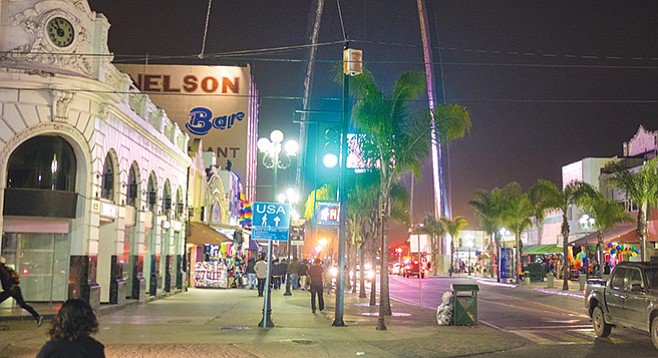It’s like a multicultural limbo,” said Ken Terry, a daily border crosser. “In Mexico, I’m the gringo. In America, I’m the white Mexican. I’m stuck in the middle and seem to be a foreigner in both places.”
I met Terry during a Reddit meetup in Tijuana last summer. Most of the people at the meeting were speaking English. Terry was trying to speak Spanish, but his lack of fluency was obvious. Short and stocky, he wore the 2015 Mexican black soccer jersey. He has green squinty eyes, light-skinned, pudgy cheeks, big nose, and small mouth that grows three times larger when he smiles.
“American wages with a Mexican cost of living is baller,” continues Terry. “I personally enjoy the way of life and energy that living in Mexico provides; however, good-paying jobs in Tijuana are hard to come by.”
He commutes to work at a casino in San Diego on a regular basis. Originally from Arizona, Terry has been a regular border-crosser since he moved to Tijuana ten months ago. In the border-crossing world, that makes him a rookie.
“I understand [Customs and Border Protection] are just doing their jobs.” Terry crosses by car through the San Ysidro Ready Lane. “They have supervisors breathing down their necks, but most of them are pretty cool and understanding. However, every now and then I’ll come across a CBP who takes their job way too seriously. Those really need to take the stick out of their asses.”
There are three lanes for vehicles entering the U.S. through San Ysidro Port of Entry: regular, Ready Lane, and SENTRI (medical lane excluded). To use the Ready Lane, a motorist must have a U.S. passport card or an enhanced driver’s license. The Secure Electronic Network for Travelers Rapid Inspection lane, better known as SENTRI, is for pre-approved travelers that hold a SENTRI or Global Entry card.
There are thousands of people in Tijuana that have a cross-border lifestyle similar to Terry’s. With approximately 350 million legal crossings annually, the U.S.-Mexico border is the most frequently crossed in the world; with over 40 million annual crossings, the Tijuana-San Diego region handles 11.4 percent of U.S.–Mexico crossing traffic.
On the north side of the border is the American dream, Southern California-style. On the south side, you have a city with poor planning and the optimism of a modern metropolis. A dark maze of a city full of mystery, smoke, brothels, bars, drugs, restaurants, bizarre art, loud music, tourist traps, and oddities.
With a population of 1.3 million, according to a 2013 census, San Diego is America’s eighth-largest city. Larger than San Diego, with an estimated population of 1.6 million, Tijuana is Mexico’s sixth-largest city. Following Detroit-Windsor, San Diego–Tijuana is the second-largest transborder agglomeration in the U.S.; it is the largest in Mexico and 19th largest metropolitan area in the Americas.
The San Ysidro border crossing is the busiest in the world. More than 50,000 northbound vehicles and 25,000 pedestrians are processed each day. It is an obsession of mine and of many others.
Tourists from both sides of the line only get a taste of the pain that is crossing the border. For the most part, the border line is composed of the same thousands of people who cross day in and day out.
“Where are you going? What were you doing in Mexico? Are you bringing anything?”
I have met hundreds of border crossers, just like Terry, who have to answer almost the same line of questioning hundreds of times per year. If you are lucky, those are the only three questions you have to answer. These are a few border crossers who I have met in my five years living in Tijuana. Participants chatted with me online about what it is like to live life on the border.
“I was ten years old when I first crossed,” writes 32-year-old Ciro Sepulveda, the promotions director for FM 94/9. “I’ve been crossing for 22 years. I used to do the daily drive, when I lived in Tijuana and worked in San Diego three years ago, but now I live in San Diego. I had SENTRI but it got stolen and I was unable to get a replacement, so now I cross through Otay. I’m mostly in San Diego, except for weekly visits to Tijuana for recreational soccer games on Tuesdays and occasional family visits on the weekends.”
Sepulveda stands six-foot-three-inches. He’s broad-shouldered, handsome, and swarthy. His full black beard is starting to show a little white. When I met him over five years ago, he lived in Tijuana and crossed daily to work. But since his SENTRI was stolen and because he has been getting more responsibilities at his job, he spends most of his time in San Diego.
“It’s a very unique geographical area, for sure. We get the comfort and luxury of a first world versus the economical value of visiting TJ for the great food or nightlife. The border doesn’t have to move that slow. It’s up to the CBP agents. Some choose to be practical and quick, others… complete dicks.”
Sepulveda keeps goal on my brother’s amateur-league soccer team. They play every Tuesday night at a turf field called Fútbol CIX. The field is situated behind the Xolos soccer stadium in Hipodromo Agua Caliente. A 20-minute drive from the border, Hipodromo is one of Tijuana’s fanciest neighborhoods. Half of the team is composed of people who live in San Diego and cross to Tijuana just to play a 40-minute soccer match.
“I’ve been crossing since I was a baby,” writes 28-year-old Paola Valdivia, an activities assistant at an elder-care facility. “My earliest crossing memory is to go buy juguetes at Toys R Us. Now I work 40 hours a week from Monday to Friday, so I stay in San Diego and on my days off I go to Tijuana. When I was working 24 hours a week, on the weekends, I would cross from Tijuana to work and go back.”





